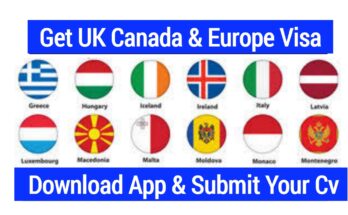1. Understanding the Different Types of Canada Visas
When embarking on your journey to apply for a Canada visa, the first and most crucial step is understanding the various types of visas available to you. Canada offers a diverse range of visa categories, each tailored to meet specific needs and circumstances.
Whether you’re looking to study, work, visit, or immigrate permanently, there’s a visa designed for your unique situation.**Temporary Resident Visa (TRV)**: This visa is primarily for individuals who wish to visit Canada for a short duration, typically for tourism, business, or family visits. A TRV allows you to stay in Canada for a limited time, usually up to six months.
**Study Permit**It’s important to note that not all travelers need a TRV; some may be eligible for an Electronic Travel Authorization (eTA) instead.Study Permi**: If your goal is to pursue education in Canada, a study permit is essential. This document allows international students to enroll in designated learning institutions across the country.
Keep in mind that you must be accepted by a recognized institution before applying for this permit, and you may also need to show proof of sufficient funds to cover your tuition and living expenses.**: For those looking to work in Canada, a work permit is a must-have.
**Work Permit**There are two main types: the employer-specific work permit, which allows you to work for a specific employer, and an open work permit, which provides more flexibility to work for any employer in Canada. Obtaining a work permit often requires a job offer from a Canadian employer and may involve a Labour Market Impact Assessment (LMIA).
**Permanent Residency**: If your aspiration is to settle in Canada permanently, you’ll need to consider pathways to permanent residency. The Express Entry system is a popular route for skilled workers, while family sponsorship options are available for those with relatives in Canada. Each pathway has its own set of criteria, including age, education, work experience, and language proficiency.
**Visitor Visa vs. ETA**: Finally, it’s essential to differentiate between the Visitor Visa (TRV) and the Electronic Travel Authorization (eTA). While both allow entry into Canada, the eTA is available exclusively for visa-exempt travelers flying to Canada and is linked electronically to your passport, making the process quicker and more streamlined.
Understanding these categories is pivotal as you prepare your application. Researching the specific requirements and conditions of each visa type will help you make informed decisions and streamline the application process, setting you on the right path toward realizing your Canadian dreams.
Apply Form Fo Canada Click Here
2. Eligibility Criteria: Who Can Apply?
Understanding the eligibility criteria is paramount to successfully navigating the Canada visa application process. Canada welcomes a diverse array of applicants, but specific requirements exist to ensure you qualify for the visa category you are pursuing. Here’s a breakdown of the primary eligibility factors to consider:
Dubai Visa Apply Foram Click Here
Uk Visa Apply Form Click Here
**1. Purpose of Visit:** The first step in determining your eligibility is clarifying the purpose of your visit. Are you planning to work, study, or reside permanently in Canada? Each category—temporary resident visas (TRVs), study permits, or permanent residence—has distinct criteria. For instance, students must be accepted by a designated learning institution, while work visa applicants typically need a job offer from a Canadian employer.
Portugal Visa Apply Form Click Here
**2. Financial Stability:** Demonstrating financial stability is crucial regardless of the visa type. You must provide proof that you can support yourself and any accompanying family members during your stay in Canada. This might include bank statements, pay stubs, or letters of employment. The required amount can vary based on the length of your stay and the number of dependents you are bringing with you.
Dubai Visa Apply Form Click Here
**3. Health and Character Requirements:** Canada places great importance on the health and safety of its residents. As part of your application, you may be required to undergo a medical examination to ensure you do not pose a health risk to the public. Additionally, you will need to provide police clearance certificates to demonstrate that you have a clean criminal record.
**4. Language Proficiency:** For certain visa categories, particularly those related to immigration or permanent residency, you must prove proficiency in English or French. This usually involves taking standardized language tests such as IELTS or CELPIP for English, or TEF for French, to assess your reading, writing, listening, and speaking skills.
**5. Age and Education:** Some visa programs have specific age and educational requirements. For example, skilled workers applying for permanent residency through the Express Entry system must have their educational credentials assessed by a recognized Canadian authority to ensure they meet Canadian standards.
**6. Admissibility Factors:** Lastly, it’s essential to check if there are any admissibility issues that may affect your application. This could include previous immigration violations, criminal charges, or health concerns that could lead to your application being denied.
By thoroughly understanding these eligibility criteria, you can better prepare your application and increase your chances of successfully obtaining a Canada visa. Remember, each case is unique, so take the time to research the specific requirements relevant to your situation, and don’t hesitate to seek professional advice if needed.
3. Step-by-Step Guide to the Application Process
Navigating the Canada visa application process can seem daunting, but breaking it down into manageable steps can significantly ease your journey. Here’s a step-by-step guide to help you through the process, ensuring you stay organized and informed every step of the way.
**Step 1: Determine Your Visa Type**
Before you dive into the application process, it’s crucial to identify the specific type of visa you need. Canada offers various visa categories, including visitor, study, work, and permanent residency visas. Research each category thoroughly to understand the requirements and restrictions associated with your preferred option.
**Step 2: Gather Required Documents**
Once you’ve settled on the type of visa, compile a checklist of all necessary documents. Generally, you’ll need identification (such as a passport), proof of financial support, and any additional paperwork specific to your visa type, such as an acceptance letter from a Canadian educational institution for student visas or a job offer for work permits. Ensure that all documents are up-to-date and accurately reflect your situation.
**Step 3: Complete the Application Form**
Access the official Canada immigration website to download the appropriate application form for your visa type. Carefully fill in all sections of the form, ensuring accuracy to avoid delays or rejections. Be thorough and honest in your responses; discrepancies can lead to complications down the line.
**Step 4: Pay the Application Fee**
After completing your form, you will need to pay the application fee. The fee varies depending on the visa type, so check the most current amounts on the official website. Keep a record of your payment receipt; you’ll need it for your application.
**Step 5: Submit Your Application**
With your completed application form and supporting documents in hand, it’s time to submit your application. Depending on your visa type, you can either apply online or through a paper application sent to the appropriate processing center. If applying online, ensure you follow all digital submission guidelines carefully.
**Step 6: Biometrics Appointment**
For many visa types, you may need to provide biometrics (fingerprints and a photo). After submitting your application, you’ll receive instructions on how to schedule a biometrics appointment at a designated location. Attend your appointment promptly, as failure to do so can delay your application.
**Step 7: Wait for Processing**
Once you’ve submitted your application and provided biometrics, the waiting period begins. Processing times vary, so check the official website for estimates based on your visa type. Use this time wisely by preparing for your potential move or travel, but remember to keep an eye on your email for any updates from immigration officials.
**Step 8: Receive Your Decision**
After processing, you will receive a decision regarding your visa application. If approved, congratulations! Review the instructions provided for your next steps, which may include additional documentation or travel arrangements. If your application is denied, don’t be discouraged; review the reasons for denial, rectify any issues, and consider reapplying if possib.
**Step 9: Prepare for Arrival**
If your visa is approved and you’re preparing to enter Canada, ensure you have all necessary documents ready for your arrival. This includes your passport, visa, and any additional paperwork required by Canadian customs. Familiarize yourself with Canadian customs regulations to ensure a smooth transition into your new environment.
Apply For Free Visa
By following this step-by-step guide, you can streamline your Canada visa application process and increase your chances of a successful outcome. Remember, preparation and attention
4. Preparing Your Documents: What You Need
When it comes to applying for a Canada visa, having the right documents in order is absolutely crucial. The process can be daunting, but meticulous preparation can make a significant difference in your application’s success. Start by creating a comprehensive checklist based on the specific type of visa you are applying for, as requirements may vary significantly between visitor, study, work, or permanent residency visas.

